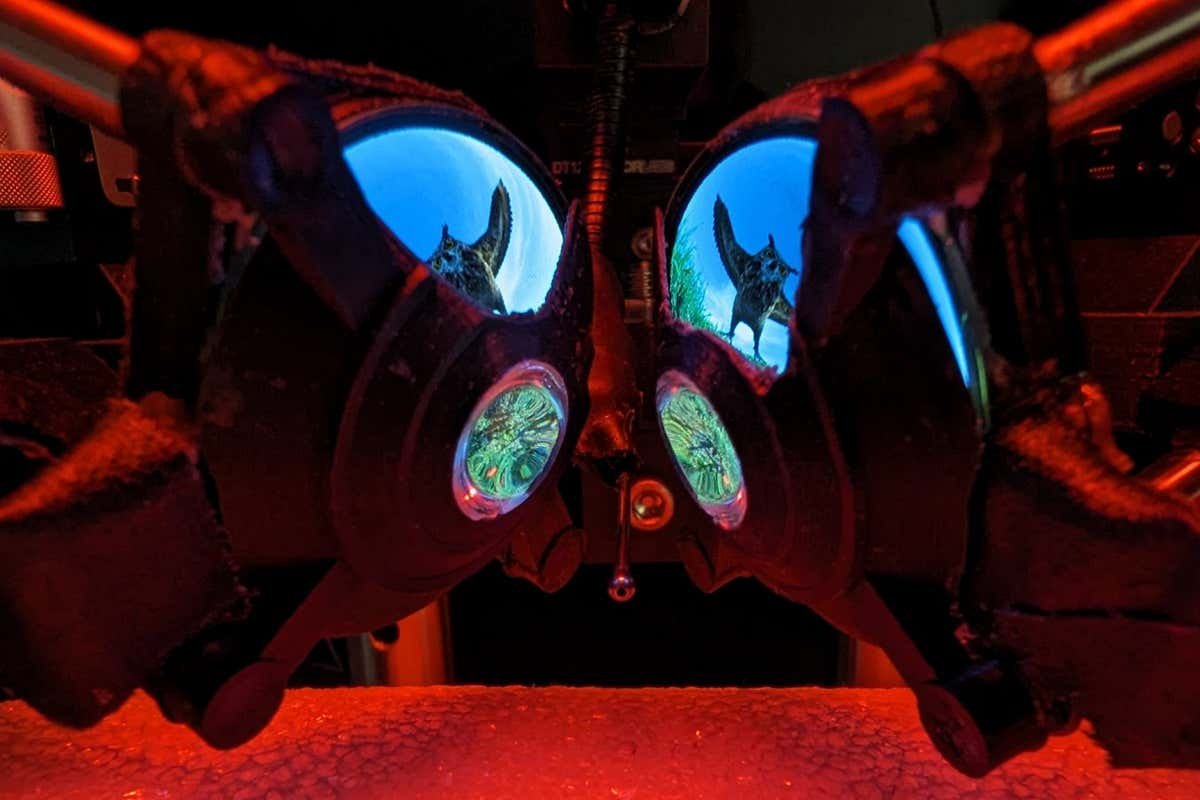
A scenario that a mouse might see as it wears the virtual reality goggles
Dom Pinke
Tiny virtual reality goggles for mice create convincing worlds that allow scientists to study the animals’ brain activity in a range of scenarios. The technology takes rodent neuroscience closer to The Matrix, towards a simulation that is indistinguishable from the real world, according to the researchers
For around 20 years, Daniel Dombeck at Northwestern University in Illinois and his colleagues have used rudimentary virtual reality to learn more about the way that mice’s brains work.
Machines that observe brain patterns are too large to be attached to freely moving mice. Instead, the team placed screens showing a virtual reality world around a mouse as it was held inside such a machine and then put it on a treadmill. The researchers could then create a virtual world where the mouse navigated any environment they designed.
“We can have them run through virtual mazes, imaging their brains to see which neurons are forming memories and remembering where they are,” says Dombeck. “[But] it’s a flat thing that the animal is looking at and there’s no depth perception, and the mice can see stuff that isn’t part of the projection. So there’s all these cue conflicts that are around and they’re not, we think, fully engaged and immersed in the environment. They’re not fully tricked.”
To solve that problem, the researchers have now created tiny goggles that cut out everything from a mouse’s field of view except the virtual world, with a different screen for each eye to create convincing depth perception. They believe this will allow them to run more accurate experiments, as mice will be more convinced of the illusion and therefore behave more naturally.
But designing goggles for mice isn’t as simple as just miniaturising technology made for people. While humans have a field of view of just over 200 degrees, it is up to 320 degrees in mice.
This means the screens within their goggles need to be curved and almost surround their eyeballs. The screens can only display 400 pixels square, but Dombeck says that is enough to be convincing, as the vision of mice is far less detailed than that of people.
“Our first use of the goggles in the first set of mice was pretty remarkable,” says Dombeck. “The mice seemed to engage very quickly. We put the goggles on – it’s all black, they don’t see anything – and then we turn on the virtual rendering. The first mouse kind of sat up and was like ‘Whoa, what is this?’ and then started moving around pretty naturally, which typically doesn’t happen with those flat projection screens.”
Dombeck says the long-term goal is to make technology for mice equivalent to that seen in The Matrix, with additional equipment to trick their senses of smell, hearing and touch.
Topics:

Felecia Phillips Ollie DD (h.c.) is the inspiring leader and founder of The Equality Network LLC (TEN). With a background in coaching, travel, and a career in news, Felecia brings a unique perspective to promoting diversity and inclusion. Holding a Bachelor’s Degree in English/Communications, she is passionate about creating a more inclusive future. From graduating from Mississippi Valley State University to leading initiatives like the Washington State Department of Ecology’s Equal Employment Opportunity Program, Felecia is dedicated to making a positive impact. Join her journey on our blog as she shares insights and leads the charge for equity through The Equality Network.





Existe – T – Il un moyen de récupérer l’historique des appels supprimés? Ceux qui disposent d’une sauvegarde dans le cloud peuvent utiliser ces fichiers de sauvegarde pour restaurer les enregistrements d’appels de téléphone mobile. https://www.mycellspy.com/fr/tutorials/how-to-recover-deleted-call-history-from-husband-phone/